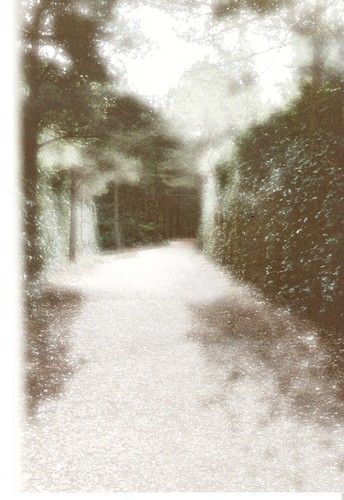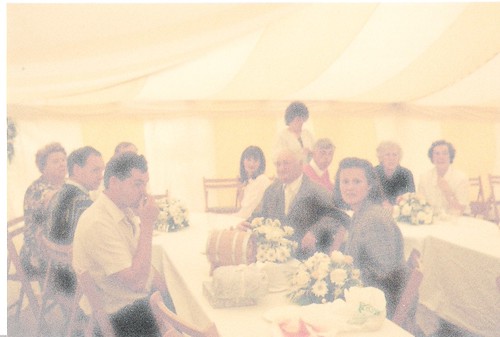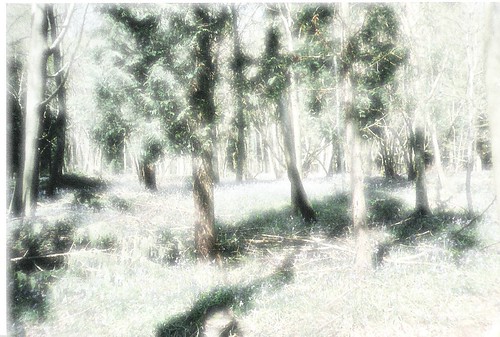Artefacts

This is a lot of things: it grew out of an essay I tried to write on photography, taking my own experiments with digital and chemical (my own term – most refer to it as ‘classical’ photography) photography as a basis; as a new batch of these photo-experiments (classed in the ‘Artefacts’ section of my Flickr page) is being prepared as I write this, and I fear this may be the last opportunity I have for such work – or, indeed, for blogging about – I wanted to try and explain the ideas behind it, and try and exorcise some of my own theoretical obsessions about it. Anyway, this is it…
Ghost Hardware

The world can no longer evade our gaze. Every corner, every nook and cranny, is being documented, archived and explained. Through the internet anyone can find pictures of anywhere, from any angle, at any time of day or night; social gatherings, the entire mystery of codes, signs, gestures, gazes, expressions, is being taken into another, digital life, given solidity through ones and zeroes. Photo sites such as Flickr or Photobucket aspire to act as communities, with each ‘camera’ documenting certain aspects of life, in certain locations (Flickr now comes with a ‘Map’ feature that allows you to identify exactly where a photo was taken); lives, those previously inscrutable things that literary creators spent the last two centuries trying to crack, can now be reduced to a series of images (with captions of choice) of anything – pets, sunsets, food, faces (your own or others), buildings, artworks, landscapes, objects (shoes, keys, CDs or vinyl, books, cups, ovens, DVD players, whatever), people, music, etc. ad infinitum. This has, to a great extent, been something liberating – the idea of viral documentation, allowing anyone to take pictures, and giving anyone the access to yours, is marvellously attractive; indeed, I would never have done anything with the massive archive of pictures I’ve shoved from hard-drive to hard-drive over the last few years, nor started taking pictures of gigs if it hadn’t been for Flickr (some may argue that the latter would have been better not happening), but one can’t help the feeling that something has irrevocably changed, and in the process been lost.
It’s at least partly a function of the technology – the new movement is inextricably bound up with the change from chemical to digital photography. This isn’t merely a question of pedantry: there is a definite aesthetic difference between the two. In Lights Out For The Territory’s essay ‘Cinema Purgatorio’, Iain Sinclair notes that anyone can always tell the difference between film shot on real film stock and on video. "You can usually mutter something about ‘depth of focus’, but that’s avoiding the real point" – chemical film stock allows for a greater depth and richness of picture than, say, digital video, which, as Wheeler Winston Dixon notes, is a much harsher, more flat medium; it captures light in a different way, making photos much more bright than chemical photos in the same conditions, but also producing photos with less ‘depth’ to them: looking at chemical and digital photographs of landscapes, it is immediately apparent that the digital photograph was originally pixels on a flat screen. It’s very difficult to explain the actual effect, and I suspect it’s due to something not completely connected with the actual process, which is now sufficiently developed to allow most people access to a digital camera that can produce photos to equal chemical ones – call it a metaphysics of photography, or whatever you like. The problem is not, as some chemical photographers suggest, ‘authenticity’ – which they naturally claim as their own, dismissing digital photographs on the basis that they realise they suddenly have competition – as, frankly, such notions are quite ridiculous when it comes to photography; for one thing, chemical photography changes images just as much as digital; secondly, the idea that something’s age is an indicator of how ‘genuine’ it is was brushed aside long ago (and if it were true, all music would be recorded on wax cylinders). The problem probably more a personal one, lying in the application of the medium itself: digital light seems to have been taken up as the aesthetic of brightly-lit, well-documented, international, bland-as-fuck 2007; dawdling as I sometimes do around Flickr and international fashion blogs, I can’t help but notice how the world is adjusting itself to digi-vision – the emphasis on bright fabrics (and yes, that includes Nu-Rave dayglo), photogenic accessories and, most importantly, composition, in current fashion; the tendency of the MySpace generation to revel in vanity and artificiality, and to strike poses at the drop of a hat; the relentless blandness of corporate architecture, which now appear more like extended digital ‘Artist’s Impression’s than real buildings, in the same way that multiplex films are now nothing more than extended trailers, all add up to the impression that the world is adapting to its media, getting ready for its close-up. ("Too high a resolution and we enter the time of the ubiquitous icon, that which is all-too-familiar." - K-Punk.) Digital photography and its qualities of cheapness (you only need to press a few buttons to destroy a photo), immediacy and mediocrity are changing the way we see the world, and our cultural self-perception.
Contrast this with chemical photos – now the preserve of ‘enthusiasts’, those unlucky few with more money than sense, and the archives. Look at a chemical photograph, especially one that’s sat in a box for a few years, or taken with older models of camera and film, and the difference is immediate and obvious: the surface is more matte, the colours duller and more subdued, drained; there’s an unmistakable sense of depth you don’t get with digital photographs (at least not unprinted ones), and of distance – while digital wants to TRANSPORT YOU THERE, RIGHT NOW! WITH SPONTANEITY AND INSTANT TRANSMISSION AND BRIGHT SHINY COLOURS!!!!!, chemical photos suggest that what is in the image is unattainable, something from which we are irrevocably separated. (This explains why, when you see Polaroids scanned into Flickr, or forming part of an advert for example, it is such a shocking difference – digital photography seeks to assure of a presence, a moment in time that really occurred, that could be happening NOW, whereas Polaroids already look slightly old as soon as they are taken, making us remember that the moment is no longer there.) Chemical photography, by its very nature, carries melancholy; the distortion effect caused by the limited nature of the medium, invokes a sense of something lost, of moments of time (and, possibly, attendant smiles) preserved behind lack of correct focus, or tricks of the light, glitches in the way the lens and prism convert light, the intricacies of the silver bromide-coated film. We are presented with something we cannot get at, a ghost whose presence eludes us if we try and snatch at it. (It’s worth noting here the tradition of supernatural photography, in which ghosts supposedly show up on developed film as white shadows, clouds of distortion, presences that alter the process of images taking form on the physical film.) Digital photography establishes a continual present; it has no memory. Chemical photography has nothing but, and it is a memory that slips beyond corporeal pinning-down or sufficient recall.
The Viral Archive

The last black-and-white film factory closed several years ago. The production of film for certain models of camera – notably the early Polaroid models – ceased years ago, and fierce bidding wars rage on Ebay and with camera enthusiasts (selling these precious pieces of manna at extortionate prices.) Chemical photography is fading further and further into the past, the point at which it ceases to have a future getting closer and closer. Sooner, rather than later, the only thing that will be left of chemical photography will be the photos still left, the collective archive of our civilisation. Everybody has at least some, hidden in boxes and books; the state and benevolent institutions preserve archives of photographs. They function, in a way, like the collective memory of the last century – the twentieth century was defined by the way it documented itself, it was the century of the new technology directly capturing from life, the camera; the defining events of the century, those that shaped the collective consciousness of the West (the genesis of Hollywood, the Great Depression, the two World Wars, the Holocaust, Hiroshima, the beginning of the Cold War, the Sixties, punk, Thatcher, etc.) were exposed by, and inextricably bound up with, film and photographs (think about anything of these things, and what comes to you but pictures, photos, sequences of film?)
Having now left the twentieth century, we will soon approach the point at which the cultural and documentary matrix of chemical photography will cease to be a living thing; it will pass cross to the Other Side, pass irrevocably into the past. The stocks of chemical photographs and negatives will be the only legacy of it left to us – memories detached from the head that thought them. Looking at chemical photographs from years gone by is at times a bewildering experience: the camera is a machine to ‘fix’ time, to separate fragments from the universal time-stream, to pin them down as objects outside the flux of time. One can’t shake the romantic notion that one is looking at the past itself. Mixed up with this is the knowledge that the time-stream does go on, that what one is looking at no longer is. And photographs themselves are subject to "the multiplying villainies of nature": photos and negatives bleach over time and with exposure to sunlight, become less vivid, more distant. Photographs, the ultimate Pharmakon for memory, fade just as memory does. The task of preservation pursued by official forces only slows down the process of disintegration, and does not extend to those photographs belonging to ‘ordinary’ people, a century’s worth of viral documentation slowly disappearing. (Some, admittedly, are trying to preserve these photos by digitising them, but this forgets the original relationship of the chemical photo to the event captured, producing a copy of a copy.) The viral nature of the chemical archive is what is most interesting about it: from the Fifties onwards, even working class families could afford cameras. They trusted implicitly in the nature of the photograph to document, with ontological clarity, the important events in life (holidays, birthdays, important public events) as well as day-to-day life (in my family’s own collection there are photographs of my father helping to rebuild the garage behind our house). When other recording technologies were out of reach, everyone could afford a camera. Poring over boxes of chemical photographs, one gets a feeling that the owners obviously never intended: that the jumbled, faded prints form something like a collective unconscious, a hive-mind filled with ghosts.
The Atrocity Exhibition

"’Lord, how heavy they are!’, he said impatiently, and in the same instant dropped them on to the stones, and the lens splintered and the barrel cracked: a little pool of liquid formed on the stone slab. It was inky black, and the odour that rose from it is not to be described. … ‘Don’t you see, my good man? Remember what he said to the doctor about looking through dead men’s eyes? Well, this was another way of it.’"
--M.R. James, A View From A Hill.
The relationship between the chemical photograph and the original event that it captured is difficult: the mind is conventionally unable to treat photographs as nothing more than conglomerations of ink on paper (which is what they are), but instead treats them as actual captures of moments in time. The actual nature of the medium (being just as distorting as digital, although in a different direction, so to speak), its own material transience, and the philosophical ramifications of the process itself (the transfer of certain arrangements of light existing in a certain moment to a two-dimensional material medium) prevent us from believing this is exactly so: there is an ontological disjuncture between the real event and the photographic representation; the photo both relates completely, and is completely separated from, the event. If we look at a photograph, we can see an event, can understand it, but we can get no closer to it. The chronological and ontological distortions implied by photography – bringing something both from another time, and another place, into the present time-space point – represent what K-Punk has called a "technological uncanny". Just as hearing ancient blues records through a layer of crackle provokes a sense of melancholy and distancing – "a recording surface which both refers to a (lost) presence and blocks us from attaining it" (K-Punk) – seeing chemical photographs causes a sense of orphanage, of helplessness; nostalgia (sometimes for a past we never had) is as much as anything a two-way sense of dispossession: the photos, fragments of a time past, are adrift in our own, and we ourselves are permanently separated from that foreign country called ‘the past’. This is exactly what I have tried to put across, and emphasise, in my photographs.
The photos were chosen from the family archive – a large shoebox kept in my parents’ closet, and several books of photos. The photos were deliberately chosen for their characteristics of enigma: I rejected any containing members of my family, or anyone else, I recognised, or any locations I recognised. The photographs in the box were not in chronological order, were jumbled up; the photos are completely orphaned from the time-space point where they were taken. Where possible, the original photos were faded by time and abuse. These attributes have been furthered by digitalisation: they have been pushed further from their original source by the distorting light of the digital scanner. The scans were imperfect, deliberately so: the sections of white captured around the edges of the image were kept, to emphasise the artificiality and materiality of the medium, the knowledge that they are, or were, objects. The application of digital distortion – a kind of visual static, a mediating crackle – and the occasional use of digital editing to change brightness and shading adds to this effect.
The only thing to add is that this project is explicitly hauntological: I don’t believe in it as some critics’ construct (no matter how good the critics – yes, Reynolds, Fisher, I’m looking at you – are). Hauntology is by no means just sonic – the possibilities in the visual and other fields are extremely under-investigated. (Incidentally, the visual side of the musical pop-culture matrix – a vital component, especially with regards to music before the Internet and digital photography, when music magazines and television were the main nodes of collective pop experience – is rather under-represented in their writings. One of the most interesting aspects of Greil Marcus’ Lipstick Traces was the role that photos and their reading – from the stacked bodies at Treblinka to the damaged photo of Debord from Ion – played in constructing the narrative and searching out the hidden currents of history.) Hauntology – emerging as it does from Derrida’s study of Marx after the ‘End Of History’ – is the most important means of exploring the nature of our culture in an age in which memory is being systematically replaced by archives no-one wants to visit.


1 Comments:
Hello. And Bye.
Post a Comment
<< Home